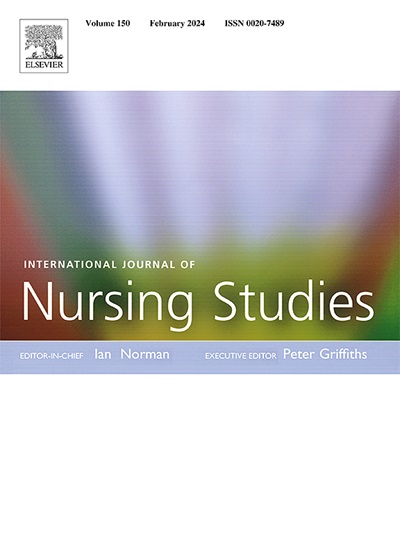非药物干预缓解重症监护病房患者口渴的有效性:网络荟萃分析。
IF 7.1
1区 医学
Q1 NURSING
引用次数: 0
摘要
背景:口渴是重症监护病房患者普遍存在的临床显著症状。然而,各种非药物干预缓解口渴的相对有效性仍然很大程度上不清楚。目的通过综合直接和间接证据,评价非药物干预对重症监护病房患者解渴的比较效果。DESIGNA系统评价和网络荟萃分析。数据来源我们对16个电子数据库和ClinicalTrials.gov进行了全面检索,从开始到2024年11月20日进行了随机对照试验。筛选、数据提取、编码和偏倚风险评估独立进行,一式两份。初步分析利用随机效应网络荟萃分析来评估非药物干预在降低口渴强度方面的有效性。使用网络元分析(CINeMA)在线工具评估证据质量。本研究已在PROSPERO注册(CRD42024606388)。结果共有14项研究,包括1642例危重患者,符合纳入标准,并评估了13种缓解口渴的非药物干预措施。与常规口腔护理相比,按其表面累积排序曲线(SUCRA)排列,薄荷液喷雾(82.4%)、室温水喷雾(82.3%)、薄荷糖(81%)、柠檬液喷雾(78.8%)、喝少许冰水(65.3%)、冰水喷雾(51.3%)干预措施的疗效均有统计学意义(P < 0.05)。CINeMA评估表明,证据的总体确定性仍然很低。结论:本网络荟萃分析提示薄荷液体喷雾剂可能对ICU患者解渴有好处,表明喷雾剂保湿是一种有前景的策略。我们提倡全面的ICU口腔护理,强调量身定制的干预措施,并将低温和薄荷醇辅助物纳入标准护理方案。这样的策略可能有助于缓解口渴相关的痛苦和优化重症监护结果。然而,需要进一步的高质量、标准化研究来验证这些发现。本文章由计算机程序翻译,如有差异,请以英文原文为准。
Effectiveness of non-pharmacological interventions for relieving thirst in intensive care unit patients: A network meta-analysis
Background
Thirst is a prevalent and clinically significant symptom among intensive care unit patients. However, the comparative effectiveness of various non-pharmacological interventions for relieving thirst remains largely unclear.
Objectives
To evaluate the comparative effectiveness of non-pharmacological interventions for thirst alleviation in intensive care unit patients through a synthesis of direct and indirect evidence.
Design
A systematic review and network meta-analysis.
Data sources
A comprehensive search of sixteen electronic databases and ClinicalTrials.gov was conducted for randomized controlled trials from inception to November 20, 2024.
Review methods
Screening, data extraction, coding, and risk of bias assessment were performed independently and in duplicate. The primary analysis utilized random-effects network meta-analysis to assess the effectiveness of non-pharmacological interventions in reducing thirst intensity. The quality of evidence was assessed using the Confidence in Network Meta-Analysis (CINeMA) online tool. This study was registered in PROSPERO (CRD42024606388).
Results
A total of 14 studies, encompassing 1642 critically ill patients, met the inclusion criteria and evaluated 13 non-pharmacological interventions for thirst alleviation. Compared to routine oral care, the following interventions showed statistically significant efficacy (all P < 0.05), ordered by their surface under the cumulative ranking curve (SUCRA): mint liquid spray (82.4 %), room temperature water spray (82.3 %), menthol lozenge (81 %), lemon liquid spray (78.8 %), drinking a little ice-cold water (65.3 %), and ice-cold water spray (51.3 %). The CINeMA assessment indicated that the overall certainty of the evidence remained low.
Conclusions
This network meta-analysis suggests that mint liquid spray may appear to offer benefits for relieving thirst among ICU patients, indicating that spray-based moisturization is a promising strategy. We advocate for comprehensive ICU oral care, emphasizing tailored interventions and the integration of low-temperature and menthol adjuncts into standard care protocols. Such strategies may help alleviate thirst-related distress and optimize critical care outcomes. However, further high-quality, standardized studies are required to verify these findings.
求助全文
通过发布文献求助,成功后即可免费获取论文全文。
去求助
来源期刊
CiteScore
15.00
自引率
2.50%
发文量
181
审稿时长
21 days
期刊介绍:
The International Journal of Nursing Studies (IJNS) is a highly respected journal that has been publishing original peer-reviewed articles since 1963. It provides a forum for original research and scholarship about health care delivery, organisation, management, workforce, policy, and research methods relevant to nursing, midwifery, and other health related professions. The journal aims to support evidence informed policy and practice by publishing research, systematic and other scholarly reviews, critical discussion, and commentary of the highest standard. The IJNS is indexed in major databases including PubMed, Medline, Thomson Reuters - Science Citation Index, Scopus, Thomson Reuters - Social Science Citation Index, CINAHL, and the BNI (British Nursing Index).

 求助内容:
求助内容: 应助结果提醒方式:
应助结果提醒方式:


